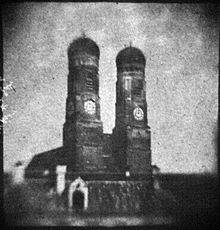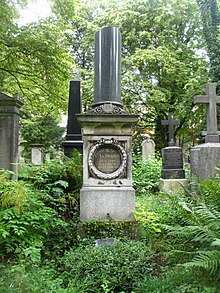Carl August von Steinheil

Carl August von Steinheil (born October 12, 1801 in Rappoltsweiler , Alsace , † September 12, 1870 in Munich ) was a German physicist , astronomer , optician and entrepreneur.
origin
His parents were Carl Philipp Steinheil (1747-1830) and his wife Christiane Maria Franziska von Biasowski. His father was general rent master of Count Palatine Max Josef of Bavaria in the county of Rappoltstein. The family belonged to the Palatinate nobility, but Carl Philipp already Steinheil had not let the needle enter in Bavaria and of rarely used.
Live and act
Steinheil studied from 1821 at the Friedrich-Alexander University in Erlangen rights , then in Goettingen and Friedrich Wilhelm Bessel in Konigsberg astronomy and physics . In Erlangen Steinheil was a member of the officially banned fraternity.
After completing his studies in 1825, he lived as a private scholar on his father's estate at Perlachseck , doing astronomical, physical and mechanical work (developing his prism circle). In 1833 a sheet of the star map series of the Royal Prussian Academy of Sciences in Berlin created by Steinheil was published. In 1835 he was appointed curator of the state's mathematical and physical collection and at the same time appointed professor of mathematics and physics at the University of Munich .
Steinheil constructed and built the first usable writing telegraph in 1836 (see Steinheilschrift ). It was the first telegraph with a magnetic inductor as a transmitter. But under the German conditions at the time, the device only aroused academic interest. In 1838 he carried out electrical tests on the tracks of the Ludwig Railway in Fürth . This led to a practice-related rediscovery of the electrical conductivity of the earth (earth return). The basic conductivity of the ground was discovered in 1803 by Friedrich Heinrich Basse . The rediscovery meant a significant simplification for telegraphy .
In 1839 he constructed a tube-shaped camera from sliding cardboard tubes and used it to photograph the Glyptothek and the towers of the Frauenkirche together with his colleague Franz Ritter von Kobell in Munich . They used chlorine silver paper as a light-sensitive material . They photographed the negatives again and thus received positives. These round photos were about 4 cm in diameter. They called the procedure the Steinheil procedure . They published their new procedure four months before Louis Jacques Mandé Daguerre .
Also in 1839 he invented and implemented the principle of a clock system with a master clock ("normal clock") and several slave clocks, which is still common today .
In 1842 he was commissioned by the Bavarian government to regulate the Bavarian weights and measures. In connection with this work, he earned services to improve the beer and alcohol scales. Steinheil was appointed by the Neapolitan government in 1846 to regulate the system of measurements and weights there.
Steinheil tried again and again to have electrical telegraph lines installed in Germany. In 1849 he undertook an inspection tour through the German states on behalf of the Bavarian government. He gave a report describing the existing electrical telegraph systems. For reasons that cannot be ascertained, however, it was passed over to the organization of the Bavarian telegraph system. Therefore he accepted the request of the Austrian government to build up the local telegraph system. He entered the Austrian service as head of the Department of Telegraphy in the Ministry of Commerce and renewed and expanded the telegraph system for all crown lands . In 1850 he also took part in the establishment of the German-Austrian Telegraph Association in Dresden. In 1851 he followed a call from the Swiss government to set up the telegraph system in this country.
In 1852 he returned to Munich in his old position as curator of the mathematical and physical collections of the state of Bavaria. With this return a promotion to the Ministerialrat in the Ministry of Commerce was connected (with a corresponding salary increase).
The year he returned to Munich, Steinheil and Léon Foucault invented a method for mirroring glass surfaces using a thin layer of silver. This was a decisive step for the development of large mirror telescopes , which should soon replace the refractors as the most powerful astronomical instruments. A basis for this invention was his scientific work on the laws of electroplating .
Steinheil also constructed a pyroscope and a centrifugal gun .
In 1855 Steinheil complied with a personal request of the Bavarian King Maximilian II and founded an optical workshop in Schwabing , which later became the optical-astronomical institute CA Steinheil & Sons . He was supported by his son Hugo Adolph Steinheil . In 1860 his second son Eduard Steinheil also joined the company. The company was continued by Hugo Adolph Steinheil from 1862. The company was temporarily located in Suresnes Castle .
The company produced excellent telescopes , spectroscopes and the first photometer that was suitable for measuring the brightness of stars. CA Steinheil was interested in photometry and Ludwig Seidel , who also acted as a scientific advisor to the company after the founder's death.
He was elected an extraordinary member of the Bavarian Academy of Sciences in 1835 and a full member in 1837 . In December 1835 he was accepted as a corresponding member of the Russian Academy of Sciences in Saint Petersburg . In 1837 he was also elected a corresponding member of the Göttingen Academy of Sciences . In 1846 he became a member of the Leopoldina . In 1866 he was elected a corresponding member of the Prussian Academy of Sciences .
tomb
The tomb of Carl crystal healing is on the old southern cemetery in Munich (burial ground 34 - Series 1 - Place 20/21) Location .
Others
In Berlin at the Postfuhramt on the facade of the first floor between the arches of the windows there are 25 medallions of personalities who have made services to the postal service. No. 24 is dedicated to Steinheil because of his reasons for electromagnetic telegraphy and the construction of the first pressure telegraph.
There is an asteroid (30837) Steinheil and a lunar crater Steinheil , which together with the Watt crater forms a double crater on the south-eastern edge of the moon.
The streets in Maxvorstadt in Munich , Erlangen-Bruck , Ingolstadt, Würzburg and Nuremberg, Steinheilgasse in Vienna - Floridsdorf and the Steinheilpfad in Berlin-Lichterfelde are named after him .
In the Stöttham district of the Chieming community there is the Steinheilhof, which the family uses as a summer residence.
family
He married Magaretha Amalie Steinheil , a daughter of the businessman Friedrich Christian Jakob Steinheil , on September 2, 1827 in Frankfurt am Main . The couple lived on Gut Perlachseck near Munich and had several children, including:
- Wilhelm Eduard (1830–1878) ⚭ 1863 Charlotte Johanna Müller
- Hugo Adolph (1832–1893) ⚭ 1858 Ida Erdinger
- Sophie Luise Marie (born October 20, 1833 - † February 10, 1859)
- Karl Friedrich (born July 3, 1836)
- Sophie Caroline Eugenie (born July 1, 1838)
- Charlotte Klara Amalie (born April 26, 1841) ⚭ 1860 Herman Schultz (1823–1890), professor of astronomy in Uppsala
- Amalie Franziska Monika (born April 17, 1843)
literature
- Constantin von Wurzbach : Steinheil, Karl August . In: Biographisches Lexikon des Kaiserthums Oesterreich . 38th part. Kaiserlich-Königliche Hof- und Staatsdruckerei, Vienna 1879, pp. 97–99 ( digitized version ).
- Robert Knott: Steinheil, Karl August . In: Allgemeine Deutsche Biographie (ADB). Volume 35, Duncker & Humblot, Leipzig 1893, pp. 720-724.
- Manual dictionary of electrical telecommunications , 2nd edition, 3rd volume; P. 1594
- EE von Georgii-Georgenau, Biographical-genealogical sheets from and about Swabia , p. 970 f.
- Johann Adolf Repsold : Carl August Steinheil. In: Astronomical News . Volume 203 (1916), Col. 165-192.
- Royal Academies of Sciences in Berlin and Munich (ed.): Correspondence between Bessel and Steinheil. Leipzig / Berlin 1913.
Web links
- Literature by and about Carl August von Steinheil in the catalog of the German National Library
- Article by / about Karl August Steinheil in the Polytechnisches Journal
- Publications by CA von Steinheil in the Astrophysics Data System
- Cornelia Meyer-Stoll: The regulation of the Bavarian national dimensions (PDF; 294 kB), Akademie Aktuell 3/2005
- Video at ARD-Alpha, 16 min. (Online until April 27, 2022) Stories of great spirits: Joy in the experiment Justus von Liebig (1803-1873 / founder of organic chemistry), Carl August von Steinheil (1801-1870 / photography pioneer) and Luise von Kobell (1828-1901 / writer) discussing on a stage in the old southern cemetery.
Individual evidence
- ^ Friedrich Reuter: The Erlanger fraternity 1816-1833. A contribution to the inner history of the restoration period. Erlangen 1896
- ^ Jürgen Hamel : Bessel's project of the Berlin academic star maps. In: The Stars. Vol. 65 (1989), pp. 11-19.
- ↑ Carl August von Steinheil: Use of the railway with the installation of galvanic telegraphy. Report to the Kgl. General Conservatory in Munich 1838; Archives for mail and telegraphy: In memory of Steinheil. Berlin, July 1888, No. 13; Both writings are reprinted in: Rundfunk und Museum. Magazine of the Rundfunkmuseum der Stadt Fürth. Issue 72, March 2010. p. 25 ff.
- ↑ Fotonexus: paper as photographic image storage ( memento of the original from August 26, 2014 in the Internet Archive ) Info: The archive link was inserted automatically and has not yet been checked. Please check the original and archive link according to the instructions and then remove this notice.
- ^ Kurt Wilhelm : Where God would live on earth , Paul Neff Verlag, Vienna 1987, ISBN 3-7014-0247-7
- ↑ VDE Committee "History of Electrical Engineering": Chronicle of Electrical Engineering, keyword: Steinheil ( Memento of the original from January 7, 2017 in the Internet Archive ) Info: The archive link was automatically inserted and not yet checked. Please check the original and archive link according to the instructions and then remove this notice. www.vde.com, accessed on May 8, 2016
- ↑ JE Bosschieter: The evolution of electric clocks - B. The first inventors www.electric-clocks.nl, Retrieved on May 8, 2016
- ^ Alfons Kauffeldt: German technicians from six centuries, Verlag Enzyklopädie Leipzig, 1963, p. 66
- ↑ Voigt, E. (1906), pp. 183ff
- ^ Foreign members of the Russian Academy of Sciences. Carl August Steinheil. Russian Academy of Sciences, accessed November 9, 2015 (Russian).
- ↑ Holger Krahnke: The members of the Academy of Sciences in Göttingen 1751-2001 (= Treatises of the Academy of Sciences in Göttingen, Philological-Historical Class. Volume 3, Vol. 246 = Treatises of the Academy of Sciences in Göttingen, Mathematical-Physical Class. Episode 3, vol. 50). Vandenhoeck & Ruprecht, Göttingen 2001, ISBN 3-525-82516-1 , p. 232.
- ^ Member entry by Carl August von Steinheil at the German Academy of Natural Scientists Leopoldina , accessed on September 18, 2017.
| personal data | |
|---|---|
| SURNAME | Steinheil, Carl August von |
| BRIEF DESCRIPTION | German physicist |
| DATE OF BIRTH | October 12, 1801 |
| PLACE OF BIRTH | Rappoltsweiler , Alsace |
| DATE OF DEATH | September 12, 1870 |
| Place of death | Munich |



